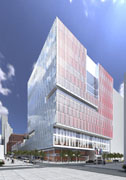
Michael Hopper
Structural Option
John Jay College Expansion Project
New York, NY
| Home |
| Michael Hopper |
| Building Statistics |
| Thesis Abstract |
| Technical Assignments |
| Research |
| Thesis Proposal |
| Presentation |
| Final Report |
| e-Studio |
| Reflection |
User Note: Note: While great efforts have been taken to provide accurate and complete information on the pages of CPEP, please be aware that the information contained herewith is considered a work‐in‐progress for this thesis project. Modifications and changes related to the original building designs and construction methodologies for this senior thesis project are solely the interpretation of Michael Hopper. Changes and discrepancies in no way imply that the original design contained errors or was flawed. Differing assumptions, code references, requirements, and methodologies have been incorporated into this thesis project; therefore, investigation results may vary from the original design. |
Technical Assignments
In the first technical report of the John Jay College Expansion Project the existing conditions are introduced through a detailed description of the foundation, floor framing, and lateral systems. Gravity and lateral loads are explored and used to justify the design of a typical bay.
In the second technical report of the John Jay College Expansion Project alternative floor systems are investigated. A typical interior bay of 30’-0” x 25’-10” was analyzed and designed for four floor systems, including the existing, and were compared based on: self weight, total structural depth, constructability, impact on the existing architecture and steel structure, fire ratings, and cost. The existing floor system is composite steel and was chosen because of its light self weight and ability to span long distances. The three other systems that are studied in this report include:
- Two-Way Flat Slab with Drop Panels,
- Two-Way Post-Tensioned Slab, and
- Pre-Cast Hollow Core Planks on Steel Beams.
In the third technical report of the John Jay College Expansion Project, an in-depth lateral analysis was performed. Existing lateral force-resisting systems are ordinary steel braced frames. A 14 story braced frame core is utilized in the tower of the expansion project, and a 5 story braced frame resists lateral forces in the cascade. There is a series of trusses at the penthouse level of the 14 story tower, which transfer gravity loads from steel plate hangers supporting floors 6 through 12 to the braced frame core.
A computer model of the John Jay College Expansion Project was created using ETABS. This model included the existing braced frame members - with modifications to the penthouse level - and rigid diaphragms connecting the frames at each level. Wind and seismic loads were calculated using ASCE 7-05 and were applied to the ETABS model.